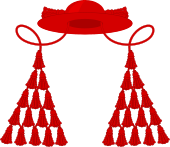Luigi Pisani
| Cardinal Luigi (Alvise) Pisani | |
|---|---|
| Cardinal-Priest | |
 | |
| Diocese | Bishop of Padua |
| Elected | 2 December 1527 |
| In office | 3 June 1570 |
| Orders | |
| Created Cardinal |
12 March 1565 by Pope Pius IV |
| Rank | Cardinal Priest of San Marco |
| Personal details | |
| Born |
1522 Venice |
| Died |
3 June 1570 Venice IT |
| Buried | Santa Maria delle Grazie, Venice |
| Nationality | Venetian |
| Parents |
Giovanni (Zuan) Pisani, Benedetta Gritti |
Luigi Pisani (1522–1570) was an Italian Roman Catholic bishop and cardinal.
Biography
Luigi (Alvise) Pisani was born in Venice in 1522,[1] the son of Giovanni Pisani, future Ambassador of the Republic of Venice to the Kingdom of France (1531), and his wife Benedetta Gritti.[2] His mother was the sister of Andrea Gritti, Doge of Venice, and his father was the brother of Cardinal Francesco Pisani.[2]
When his uncle, Cardinal Francesco Pisani, who had been Bishop of Padua since 1524, resigned the See on 2 December 1527, he did so in favor of his nephew Luigi.[3] At his tender age, Luigi was too young to be a bishop (the minimum canonical age being twenty-five), and thus the diocese needed an Administrator, who turned out to be his uncle the Cardinal. The Cardinal, therefore, was able to pursue his activities at the Papal Court (which was in exile at the time) and still collect a share of the revenues of the diocese and control over the awarding of benefices. This arrangement continued until 1555.[4] He succeeded as Administrator of the diocese of Padua in 1555, on the resignation of his uncle, Cardinal Francesco Pisani, who had been promoted Bishop of Albano by the new Pope, Paul IV (Carafa).[5] There is no reference to Luigi's taking holy orders or being consecrated a bishop, but his succession to the Diocese in 1555 may have forced the issue.
In the meantime he had moved to Rome, becoming a Cleric in the Apostolic Camera.[2] This position was for sale, and he or his family probably purchased the office. He rose in the hierarchy of the Apostolic Chamber to the office of praefectus annonae, ninth in rank, dealing with the finances of the provisioning of the Papal Court and the City of Rome. He held that post from August 1561 until May 1562.[2]
In 1562-63, he was a participant in the Council of Trent,[6] [2] which would imply that he was certainly a bishop by 1562.
Pope Pius IV made him a cardinal priest in his fourth Consistory for the creation of cardinals on 12 March 1565.[7] Pope Pius died on 9 December 1565, before Luigi had been invested with a titular church. He participated in the papal conclave of 1565-66 that elected Pope Pius V.[8] He received the red hat and the titular church of San Vitale on February 8, 1566.[9] On June 2, 1568, he opted for the titular church of San Marco.[10][2]
On 14 January 1569 he was elected to succeed Cardinal Giacomo Savelli as Chamberlain of the Sacred College of Cardinals. He served the usual one-year term, and was succeeded on 14 January 1570 by Cardinal Philibert Babou de la Bourdaisière.[11] He was never (as some report) Chamberlain of the Holy Roman Church.
He died in Venice on June 3, 1570, at the age of forty-eight,[12] three weeks before his uncle, Cardinal Francesco Pisani.[2] He was buried in the church of Santa Maria delle Grazie in Venice.[13][2]
References
- ↑ Guilelmus van Gulik & Conradus Eubel, Hierarchia catholica medii et recentioris aevi III, editio altera (Monasterii 1923), p. 40, n. 7. The Bishop of Padua, Niccolò Antonio Giustiniani (1786). Serie cronologica dei Vescovi di Padova (in Italian). Padova: Stamperia del Seminario. p. cxxxv., states that Luigi was twelve years of age when appointed to the Bishopric of Padua on 2 December 1527. That would give a birth date of 1515, not 1522. Is XII a mistake for VII?
- 1 2 3 4 5 6 7 8 Entry from Biographical Dictionary of the Cardinals of the Holy Roman Church
- ↑ Marino Sanudo (1897). Federico Stefani & Guglielmo Berchet, ed. I diarii di Marino Sanuto: (MCCCCXCVI-MDXXXIII) (in Italian). Volume XLVI (September 1527-February 1528). Venezia: F. Visentini. p. 549..
- ↑ The papal Nuncio Aleander pointed out in 1534 that three Venetian families, the Cornaro,the Gritti, and the Pisani, had cooperated in an effort to momopolize the clerical appointments in the bishoprics in Venetian territory on the mainland: Manfredo Tafuri (1995). Venice and the Renaissance. Cambridge MA USA: MIT Press. p. 113. ISBN 978-0-262-70054-2.
- ↑ Guilelmus van Gulik & Conradus Eubel, Hierarchia catholica medii et recentioris aevi III, editio altera (Monasterii 1923), p. 267.
- ↑ Francesco Sforza Pallavicino (1803). Istoria del Concilio di Trento scritta dal padre Sforza Pallavicino della Compagnia di Gesu. Volume XIV. Venezia: Giacomo Zanardi. p. 98.
- ↑ Gulik and Eubel, p. 40.
- ↑ J. P. Adams, Sede Vacante 1565-1566. Retrieved: 2016-04-06.
- ↑ Gulik and Eubel, p. 40.
- ↑ Gulik and Eubel, p. 40.
- ↑ Gulik and Eubel, p. 85.
- ↑ Gulik and Eubel, p. 40.
- ↑ L. Tettoni; F. Saladini (1847). Teatro araldico, ovvero raccolta generale delle armi ed insegne gentilizie delle casate ... che fioriscono in tutta. l'Italia. Milano: C. Wilmant. p. 362.